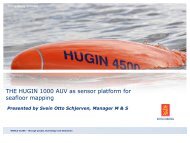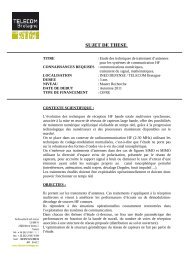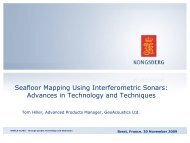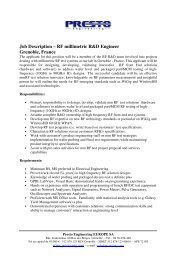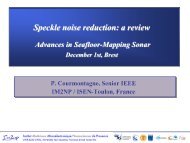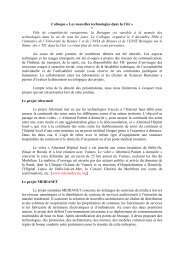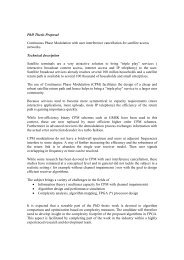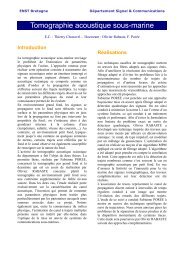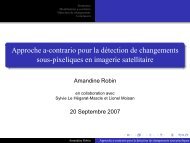Département Réseau, Sécurité et Multimédia Rapport d'Activités 2008
Département Réseau, Sécurité et Multimédia Rapport d'Activités 2008
Département Réseau, Sécurité et Multimédia Rapport d'Activités 2008
You also want an ePaper? Increase the reach of your titles
YUMPU automatically turns print PDFs into web optimized ePapers that Google loves.
Suppressing Neighbor Discovery in Wireless Sensor N<strong>et</strong>worksResearch Staff : Laurent Toutain, Bruno Stevant, E. Gall<strong>et</strong> de SanterreKeywords : Wireless IPv6, IPv6-IPv4 transitionApplications : Sensor n<strong>et</strong>works,Partners & Funding : partially funded in the framework of STIC Asia programIntroductionDescription of the problemWireless sensor n<strong>et</strong>works have recently paid alot of attention by specification organizations,in particular IEEE. IEEE 802.15.4 is atechnology designed to reduce powerconsumption based on CSMA-CA (CarrierSense Multiple Access with CollisionAdvoidance) with a throughput b<strong>et</strong>ween 20and 250 kbit/s. Several independent n<strong>et</strong>workscan be deployed on the same area. They areidentified by a PANid value. Each of thesen<strong>et</strong>works have a single PAN Coordinator (PC)that is in charge of managing attachment ofnew sensors, address allocation and optionallybandwidth allocation for some kind ofsynchronous traffic. The PC may also assureinterconnection with other n<strong>et</strong>worktechnologies. In our architecture, the borderequipment b<strong>et</strong>ween the full IPv6 world and theSensor N<strong>et</strong>work will be the PC.Zigbee has been defined by the Zigbee forumto allow applications running on top of thisMAC layer. Zigbee provides addressingcapabilities, routing and defines someapplications. Zigbee is not an end-to-endarchitecture; an equipment connected to theIntern<strong>et</strong> will contact a Zigbee coordinatorwhich will generate Zigbee traffic. IETFapproach with 6lowpan working group is quitedifferent, the goal is to re-establish full end-toendconnectivity b<strong>et</strong>ween IEEE 802.15.4equipments and others.The 6lowpan protocol [3] is an adaptationlayer used to allow the transport of IPv6pack<strong>et</strong> on Wireless Sensor N<strong>et</strong>work andparticularly IEEE 802.15.4.Neighbor Discovery Protocol is used in IPv6 toestablish relation b<strong>et</strong>ween a host and itsneighbors to find the relation b<strong>et</strong>ween theIPv6 address and the MAC address. NDP isalso widely used during the bootstrap to autoconfigureinterfaces. A vast majority ofequipments are using this protocol to configur<strong>et</strong>heir global IPv6 address and the defaultrouter. A host activating its interface, creates aLink Local address and after verifying itsuniqueness, multicasts a Router Solicitation tothe well-known router group (FF02::2address). Routers answer directly to therequesting host with a Router Advertisementmessage (RA) that may contain the prefix(es)used on the link. The host concatenates theprefix(es) with its Interface ID to generate aglobal address. The host selects also one ofthe routers as the default router. This way, thehost gains connectivity at layer 3 and is able tosend pack<strong>et</strong>s world wide on the n<strong>et</strong>work.Other param<strong>et</strong>ers such as DNS server may belearnt through DHCPv6 protocol or morerecently this param<strong>et</strong>er can be included by therouter in the RA message.In WSN, this periodic message could lead tobad performances in terms of bandwitdhusage, but also in terms of batteryconsumption. The goal of this work is to studythe consequences of period RA suppressionand to limit the solicited RS/RA to WSN reallyrequiring it and ensure end-to-endcommunications with any other deviceconnected on the Intern<strong>et</strong>.Currently, WSN n<strong>et</strong>work are simple and mainlyarranged around the PAN Coordinator. IETFhas almost finished the definition of theadaptation layer but routing inside the WSN iscurrently not standardized.The aim of this work is to propose a b<strong>et</strong>terintegration of IPv6 in IEEE 802.14.5.12 Extract of Pracom’s Annual Report <strong>2008</strong>



